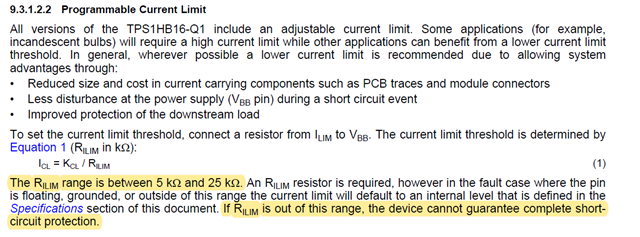

This thread has been locked.
If you have a related question, please click the "Ask a related question" button in the top right corner. The newly created question will be automatically linked to this question.


Hi Elec,
It will be a fixed value for a specific part, and the value will be fall into the range mentioned in the datasheet. If the customer wants the minimum current limit triggered at 3.8A, then customer can choose Rlim so the min of the value will be 3.8A. Customer can use linear interpolation for any value in between the Rlim listed on the datasheet.
Regards,
Yichi
Hi Yichi,
If the customer wants the minimum current limit triggered at 3.8A, then customer can choose Rlim so the min of the value will be 3.8A
As you suggest, the min trigger current limit should be 3.8A, right?
Customer can use linear interpolation for any value in between the Rlim listed on the datasheet.
I don't understand how to perform the linear interpolation. Could you please explain more? Actually I am still confused. The 9.3.1.2.2 describes that the current limit is calculated by equation 1. From my understanding the result should be a fixed value, the resistor value and the corresponding current limit. But in table, it gives a range. This makes me confused. You can take current limit 3.8A as an example to explain how to get the right resistor. Thanks a lot for your patience!
BR,
Elec Cheng
Hi Elec,
1. It would be depending on the customer's need. If customer wants to make sure no current limit is triggered under 3.8A, then the min value for current limit should be set to 3.8A. In another situation, where customer wants current limit must trigger at 3.8A (or it's okay to trigger lower), then the max value should be set to 3.8A.
2. From the calculation, it's a way to select the typical value. So say customer is okay to have current limit around 4.4A, but a bit higher or lower is okay in their application, then 25kohm can be used. However, for each part, the actual current limit value will be in a range. Say if you set to 25kohm, the current limit for one part can be 4.2A, and the current limit for another part can be 4.6A. It has a percentage accuracy here. So take 25kohm as an example, the min value is 40% lower than the typical, and for 5kohm, the min value is 17.5% lower. If you assume the percentage increases linearly, you can estimate for a 10kohm resistor, the min value can be (0.4-0.175)/(25-5)*5+0.175 percent lower than the typical value.
The Rilim calculator here:https://www.ti.com/product/TPS1HB16-Q1#design-tools-simulation can be a good tool.
Please let me know if you have additional questions.
Regards,
Yichi